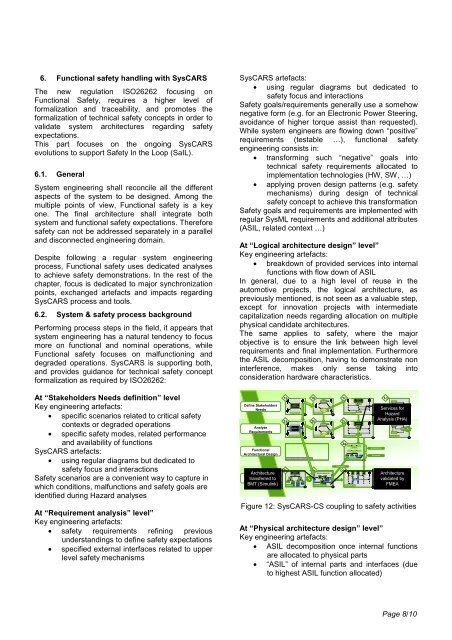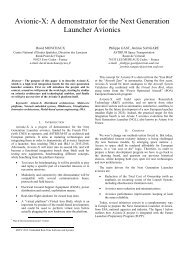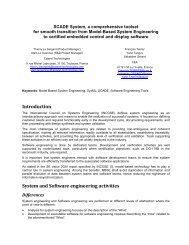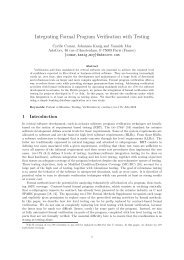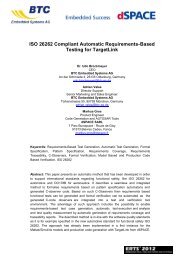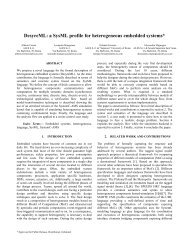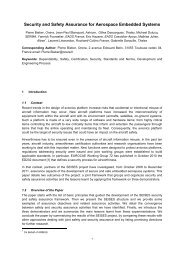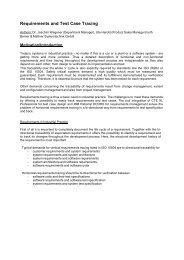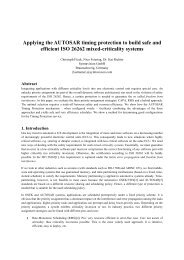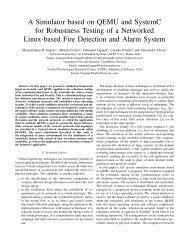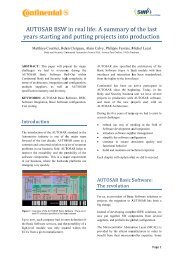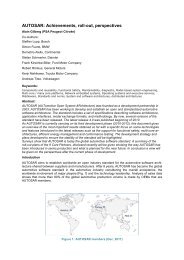SysML for embedded automotive Systems: lessons learned
SysML for embedded automotive Systems: lessons learned
SysML for embedded automotive Systems: lessons learned
You also want an ePaper? Increase the reach of your titles
YUMPU automatically turns print PDFs into web optimized ePapers that Google loves.
UNUSED IN CORE STREAM (SysCARS-CS)<br />
B1<br />
ACTORS (BDD)<br />
INTERFACES (IBD)<br />
B2<br />
B1.1 B1.2 B2.1 B2.2<br />
Fa<br />
Fc<br />
Fe<br />
PBS (BDD)<br />
Fb<br />
Fd<br />
n<br />
n<br />
1<br />
USAGE (UCD)<br />
Intent1<br />
Intent2<br />
Service1<br />
Service2<br />
SERVICES (UCD)<br />
B1.1<br />
B2.1<br />
Fc<br />
Fd<br />
B1.2<br />
Fa<br />
INTERFACES (IBD)<br />
n<br />
n<br />
n<br />
ALLOCATION<br />
SCENARIOS (SD)<br />
SCENARIOS (SD)<br />
SCENARIOS (SD)<br />
Mod3<br />
Mod1<br />
State3<br />
F<br />
1<br />
State1<br />
F1.1 F1.2 F1.2<br />
1.2.1 1.2.3 1.2.4<br />
Fa Fb Fe Fd<br />
DECOMPOSITIONS (AD)<br />
B2.1 B1.2 B2.2<br />
F<br />
c<br />
F<br />
d<br />
F<br />
a<br />
F<br />
b<br />
n<br />
n<br />
n<br />
DECOMPOSITION<br />
ALLOCATION<br />
n<br />
Mod1<br />
Mod3<br />
MODES (STM)<br />
State1<br />
State3<br />
STATES (STM)<br />
Mod2<br />
State2<br />
1<br />
1<br />
6. Functional safety handling with SysCARS<br />
The new regulation ISO26262 focusing on<br />
Functional Safety, requires a higher level of<br />
<strong>for</strong>malization and traceability, and promotes the<br />
<strong>for</strong>malization of technical safety concepts in order to<br />
validate system architectures regarding safety<br />
expectations.<br />
This part focuses on the ongoing SysCARS<br />
evolutions to support Safety In the Loop (SaIL).<br />
6.1. General<br />
System engineering shall reconcile all the different<br />
aspects of the system to be designed. Among the<br />
multiple points of view, Functional safety is a key<br />
one. The final architecture shall integrate both<br />
system and functional safety expectations. There<strong>for</strong>e<br />
safety can not be addressed separately in a parallel<br />
and disconnected engineering domain.<br />
Despite following a regular system engineering<br />
process, Functional safety uses dedicated analyses<br />
to achieve safety demonstrations. In the rest of the<br />
chapter, focus is dedicated to major synchronization<br />
points, exchanged artefacts and impacts regarding<br />
SysCARS process and tools.<br />
6.2. System & safety process background<br />
Per<strong>for</strong>ming process steps in the field, it appears that<br />
system engineering has a natural tendency to focus<br />
more on functional and nominal operations, while<br />
Functional safety focuses on malfunctioning and<br />
degraded operations. SysCARS is supporting both,<br />
and provides guidance <strong>for</strong> technical safety concept<br />
<strong>for</strong>malization as required by ISO26262:<br />
At “Stakeholders Needs definition” level<br />
Key engineering artefacts:<br />
• specific scenarios related to critical safety<br />
contexts or degraded operations<br />
• specific safety modes, related per<strong>for</strong>mance<br />
and availability of functions<br />
SysCARS artefacts:<br />
• using regular diagrams but dedicated to<br />
safety focus and interactions<br />
Safety scenarios are a convenient way to capture in<br />
which conditions, malfunctions and safety goals are<br />
identified during Hazard analyses<br />
At “Requirement analysis” level”<br />
Key engineering artefacts:<br />
• safety requirements refining previous<br />
understandings to define safety expectations<br />
• specified external interfaces related to upper<br />
level safety mechanisms<br />
SysCARS artefacts:<br />
• using regular diagrams but dedicated to<br />
safety focus and interactions<br />
Safety goals/requirements generally use a somehow<br />
negative <strong>for</strong>m (e.g. <strong>for</strong> an Electronic Power Steering,<br />
avoidance of higher torque assist than requested).<br />
While system engineers are flowing down “positive”<br />
requirements (testable …), functional safety<br />
engineering consists in:<br />
• trans<strong>for</strong>ming such “negative” goals into<br />
technical safety requirements allocated to<br />
implementation technologies (HW, SW, …)<br />
• applying proven design patterns (e.g. safety<br />
mechanisms) during design of technical<br />
safety concept to achieve this trans<strong>for</strong>mation<br />
Safety goals and requirements are implemented with<br />
regular <strong>SysML</strong> requirements and additional attributes<br />
(ASIL, related context …)<br />
At “Logical architecture design” level”<br />
Key engineering artefacts:<br />
• breakdown of provided services into internal<br />
functions with flow down of ASIL<br />
In general, due to a high level of reuse in the<br />
<strong>automotive</strong> projects, the logical architecture, as<br />
previously mentioned, is not seen as a valuable step,<br />
except <strong>for</strong> innovation projects with intermediate<br />
capitalization needs regarding allocation on multiple<br />
physical candidate architectures.<br />
The same applies to safety, where the major<br />
objective is to ensure the link between high level<br />
requirements and final implementation. Furthermore<br />
the ASIL decomposition, having to demonstrate non<br />
interference, makes only sense taking into<br />
consideration hardware characteristics.<br />
Define Stakeholders<br />
Needs<br />
Analyze<br />
Requirements<br />
Functional<br />
Architectural Design<br />
Architecture<br />
Physical<br />
transferred to<br />
Architectural Design<br />
BMT (Simulink)<br />
1a 1b 1c 1d<br />
system<br />
(context)<br />
Services <strong>for</strong><br />
Hazard<br />
Analysis (PHA)<br />
2a 2b 2c 6b<br />
system<br />
System<br />
(physical)<br />
System (physical)<br />
3a<br />
4b 4c 4d<br />
system<br />
(context)<br />
system<br />
Architecture<br />
validated by<br />
FMEA<br />
Figure 12: SysCARS-CS coupling to safety activities<br />
At “Physical architecture design” level”<br />
Key engineering artefacts:<br />
• ASIL decomposition once internal functions<br />
are allocated to physical parts<br />
• “ASIL” of internal parts and interfaces (due<br />
to highest ASIL function allocated)<br />
Page 8/10


